Kenwood Z919 User Manual
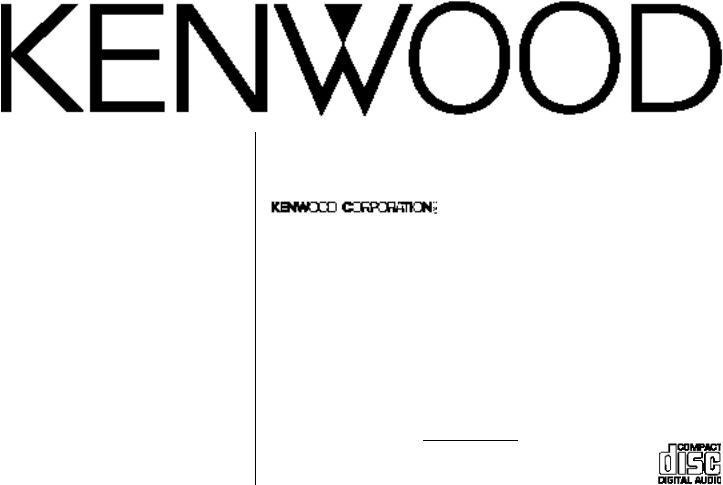
Z919 |
MULTI CONTROL CD-RECEIVER |
INSTRUCTION MANUAL |
Take the time to read through this instruction manual.
Familiarity with installation and operation procedures will help you obtain the best performance from your new CD-receiver.
For your records
Record the serial number, found on the back of the unit, in the spaces designated on the warranty card, and in the space provided below. Refer to the model and serial numbers whenever you call upon your KENWOOD dealer for information or service on the product.
Model Z919 Serial number
© PRINTED IN JAPAN B64-1687-00 (KJ) (+)
01/12 11 10 9 8 7 6 5 4 3 2 1 00/12 11 10 9 8 7 6 5 4
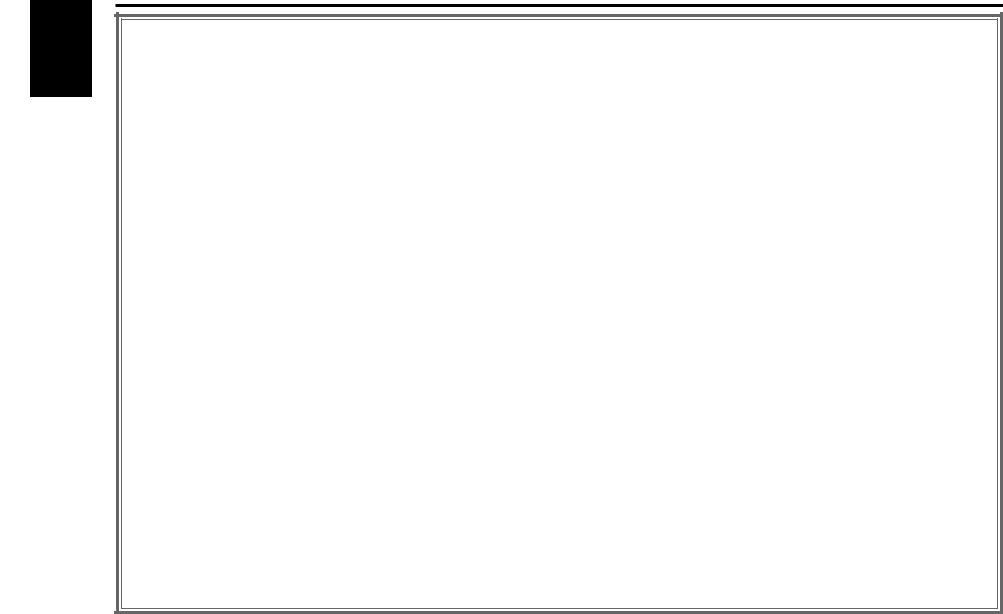
English
Contents
Before use |
|
Warning........................................................................................................ |
3 |
Safety precautions ....................................................................................... |
3 |
Notes on playing MP3 files .......................................................................... |
5 |
Handling Compact discs .............................................................................. |
8 |
General features |
|
Power........................................................................................................... |
9 |
Switching Modes ......................................................................................... |
9 |
Volume....................................................................................................... |
10 |
Loudness ................................................................................................... |
10 |
Panel Angle Adjustment ............................................................................ |
10 |
Clock Adjustment....................................................................................... |
10 |
Stopwatch.................................................................................................. |
11 |
Timer.......................................................................................................... |
11 |
Alarm.......................................................................................................... |
12 |
Automatic Dimmer Function...................................................................... |
12 |
Display Font Setting................................................................................... |
12 |
Switching the Round Indicator for the Sound Level .................................. |
12 |
Audio Control Setting................................................................................. |
13 |
Digital Crossover Network ......................................................................... |
15 |
Tuner features |
|
Tuning ........................................................................................................ |
16 |
Station Preset Memory.............................................................................. |
16 |
Auto Memory Entry ................................................................................... |
17 |
Preset Tuning............................................................................................. |
17 |
Clean Reception System Circuit (CRSC) .................................................... |
17 |
Switching Display for Tuner ....................................................................... |
17 |
Station Name Preset (SNPS)...................................................................... |
18 |
Station Name Preset Play (SBF)................................................................. |
19 |
Direct Access Tuning ................................................................................. |
19 |
CD/External disc control features |
|
Playing CDs................................................................................................ |
20 |
Playing Other Disc Mode ........................................................................... |
21 |
Fast Forwarding and Reversing Disc Play.................................................. |
21 |
Track Search .............................................................................................. |
21 |
Disc Search ................................................................................................ |
22 |
Track Repeat .............................................................................................. |
22 |
Disc Repeat................................................................................................ |
22 |
Track Scan.................................................................................................. |
22 |
Disc Scan ................................................................................................... |
22 |
Random Play .............................................................................................. |
23 |
Magazine Random Play.............................................................................. |
23 |
Text Scroll .................................................................................................. |
23 |
Direct Track Search.................................................................................... |
23 |
Direct Disc Search ..................................................................................... |
24 |
Presetting Disc Names .............................................................................. |
24 |
Switching Display for Discs ....................................................................... |
25 |
Switching Playing Time Display ................................................................. |
25 |
Search on Initials........................................................................................ |
26 |
MP3 features |
|
Playing MP3 files ....................................................................................... |
28 |
File Search ................................................................................................. |
28 |
Folder Search ............................................................................................. |
29 |
File Repeat ................................................................................................. |
29 |
Folder Repeat............................................................................................. |
29 |
Random Play .............................................................................................. |
29 |
Name Scroll for MP3.................................................................................. |
29 |
Presetting Disc Names (DNPS).................................................................. |
29 |
Direct File Search....................................................................................... |
30 |
Switching Display for MP3......................................................................... |
30 |
Folder Select .............................................................................................. |
30 |
External TV control features |
|
Tuning ........................................................................................................ |
32 |
Station Preset Memory.............................................................................. |
32 |
Auto Memory Entry ................................................................................... |
32 |
Preset Tuning............................................................................................. |
32 |
Direct Access Tuning ................................................................................. |
33 |
Function set system |
|
Function Set System.................................................................................. |
34 |
Touch Sensor Tone .................................................................................... |
34 |
Dimmer ...................................................................................................... |
34 |
Silent Display ............................................................................................. |
34 |
KEX (Sound Coordinate system) ................................................................ |
35 |
SP (Speaker selector)................................................................................. |
35 |
Basic operations of remote .................................... |
35 |
Installation |
|
Accessories................................................................................................ |
39 |
Installation Procedure ................................................................................ |
39 |
Connecting Wires to Terminals.................................................................. |
40 |
System Connection.................................................................................... |
41 |
Installation.................................................................................................. |
42 |
Removing the Unit ..................................................................................... |
44 |
Troubleshooting guide ........................................... |
45 |
Specifications ........................................................ |
48 |
— 2 —
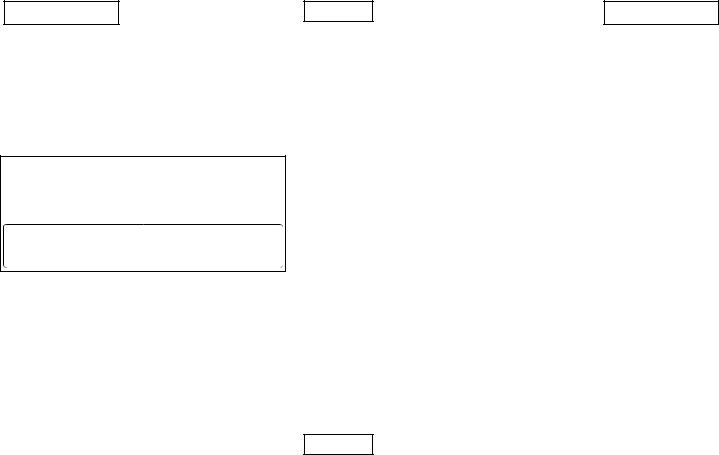
2Warning |
|
Safety precautions |
2CAUTION
Use of controls or adjustments or performance of procedures other than those specified herein may result in hazardous radiation exposure.
In compliance with Federal Regulations, following are reproductions of labels on, or inside the product relating to laser product safety.
KENWOOD CORPORATION 2967-3, ISHIKAWA-CHO, HACHIOJI-SHI
TOKYO, JAPAN
KENWOOD CORP. CERTIFIES THIS EQUIPMENT CONFORMS TO DHHS REGULATIONS N0.21 CFR 1040. 10, CHAPTER 1, SUBCHAPTER J.
Location : Bottom Panel
FCC WARNING
This equipment may generate or use radio frequency energy. Changes or modifications to this equipment may cause harmful interference unless the modifications are expressly approved in the instruction manual. The user could lose the authority to operate this equipment if an unauthorized change or modification is made.
NOTE
This equipment has been tested and found to comply with the limits for a Class B digital device, pursuant to Part 15 of the FCC Rules. These limits are designed to provide reasonable protection against harmful interference in a residential installation. This equipment may cause harmful interference to radio communications, if it is not installed and used in accordance with the instructions. However, there is no guarantee that interference will not occur in a particular installation. If this equipment does cause harmful interference to radio or television reception, which can be determined by turning the equipment off and on, the user is encouraged to try to correct the interference by one or more of the following measures:
•Reorient or relocate the receiving antenna.
•Increase the separation between the equipment and receiver.
•Connect the equipment into an outlet on a circuit different from that to which the receiver is connected.
•Consult the dealer or an experienced radio/TV technician for help.
NOTE
This Class B digital apparatus complies with Canadian ICES-003.
2WARNING
To prevent injury or fire, take the following precautions:
•Insert the unit all the way in until it is fully locked in place. Otherwise it may fall out of place when jolted.
•When extending the ignition, battery, or ground wires, make sure to use automotivegrade wires or other wires with a 0.75mm2 (AWG18) or more to prevent wire deterioration and damage to the wire coating.
•To prevent a short circuit, never put or leave any metallic objects (such as coins or metal tools) inside the unit.
•If the unit starts to emit smoke or strange smells, turn off the power immediately and consult your Kenwood dealer.
•Make sure not to get your fingers caught between the faceplate and the unit.
•Be careful not to drop the unit or subject it to strong shock.
The unit may break or crack because it contains glass parts.
— 3 —
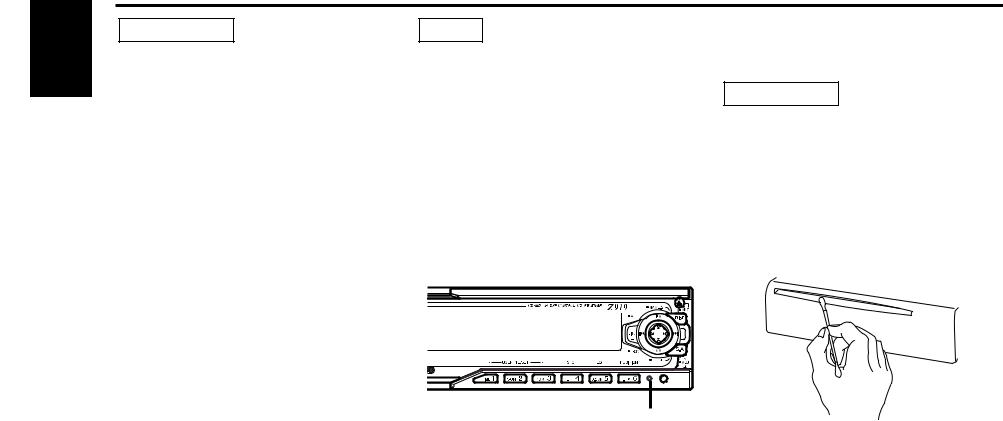
English
Safety precautions
2CAUTION
To prevent damage to the machine, take the following precautions:
•Make sure to ground the unit to a negative 12V DC power supply.
•Do not open the top or bottom covers of the unit.
•Do not install the unit in a spot exposed to direct sunlight or excessive heat or humidity. Also avoid places with too much dust or the possibility of water splashing.
•Do not subject the faceplate to excessive shock, as it is a piece of precision equipment.
•When replacing a fuse, only use a new one with the prescribed rating. Using a fuse with the wrong rating may cause your unit to malfunction.
•To prevent a short circuit when replacing a fuse, first disconnect the wiring harness.
•Do not place any object between the faceplate and the unit.
•Do not use your own screws. Use only the screws provided. If you use the wrong screws, you could damage the unit.
NOTE
•The illustrations of the display and the panel appearing in this manual are examples used to explain more clearly how the controls are used. Therefore, what appears on the display in the illustrations may differ from what appears on the display on the actual equipment, and some of the illustrations on the display may represent something impossible in actual operation.
•If you experience problems during installation, consult your Kenwood dealer.
•If the unit does not seem to be working right, try pressing the reset button first. If that does not solve the problem, consult your Kenwood dealer.
Reset button
•The functions that can be used and the information that can be displayed will differ depending on the external disc players being connected.
Cleaning the Unit
If the front panel gets dirty, turn off the power and wipe the panel with a dry silicon cloth or soft cloth.
2CAUTION
Do not wipe the panel with a hard cloth or a cloth dampened by volatile solvents such as paint thinner and alcohol. They can scratch the surface of the panel and/or cause the indicator letters to peel off.
Cleaning the CD Slot
As dust tends to accumulate in the CD slot, clean it every once in a while. Your CDs can get scratched if you put them in a dusty CD slot.
Lens Fogging
Right after you turn on the car heater in cold weather, dew or condensation may form on the lens in the CD player of the unit. Called lens fogging, CDs may be impossible to play. In such a situation, remove the disc and wait for the condensation to evaporate. If the unit still does not operate normally after a while, consult your Kenwood dealer.
— 4 —

Notes on playing MP3 files
This unit can play MP3 files.
Note, however, that the MP3 file recording media and formats acceptable are limited.
When writing MP3 files, pay attention to the following restrictions.
Acceptable media
The MP3 file recording media acceptable to this unit are CD-ROM, CD-R, and CD-RW.
Acceptable medium formats
The medium formats acceptable to this unit are ISO 9660 Level 1 and Level 2 excluding the extended formats. When reading an MP3 file written in a format other than ISO 9660 Level 1 or Level 2, the unit may fail to play the file normally or display the file or folder name correctly.
The major specifications of ISO 9660 Level 1 and Level 2 are as follows:
•Maximum number of directory levels: 8
•Maximum number of files and folders per directory level:
253 (files and folders in total)
• Characters available to file and folder names:
A - Z, 0 - 9, _(underscore)
• Maximum number of characters in file names:
Level 1 : 12 (including a separator "." and a 3-character extension) Level 2 : 31 (including a separator "." and a 3-character extension)
Settings for your MP3 encoder and CD writer
When you use your MP3 encoder to compress audio data to an MP3 file, set the transfer bit rate of the encoder to fixed 128 kbps.
When you use your CD writer to record MP3 files up to the maximum disc capacity, disable additional writing. For recording on an empty disk up to the maximum capacity at once, check Disc at Once.
Entering file and folder names
When entering file and folder names, use alphanumeric characters only. If entered with any other character, the file and folder names are not displayed correctly. They may neither be displayed correctly depending on the CD writer used.
Note that the unit cannot display ID tags even though they have been embedded in MP3 files.
The unit recognizes and plays only those MP3 files which have the MP3 filename extension (.MP3). MP3 files should therefore be saved with the MP3 extension.
Writing files into a medium
When a medium containing MP3 data is loaded, the unit checks all the files on the medium. If the medium contains a lot of folders or non-MP3 files, therefore, it takes a long time until the unit starts playing MP3 files.
In addition, it may take time for the unit to move to the next MP3 file or a file search or folder search may not be performed smoothly. You should not write non-MP3 files or unneeded folders along with MP3 files on the medium.
2CAUTION
When playing MP3 files on a medium which also contains nonMP3 files or folders, observe the following precautions. Loading such a medium may produce loud noise to break the speakers.
•Do no attempt to play a medium containing a non-MP3 file with the MP3 extension.
The unit mistakes non-MP3 files for MP3 files as long as they have the MP3 extension.
•Do not attempt to play a medium containing non MP3 file.
— 5 —
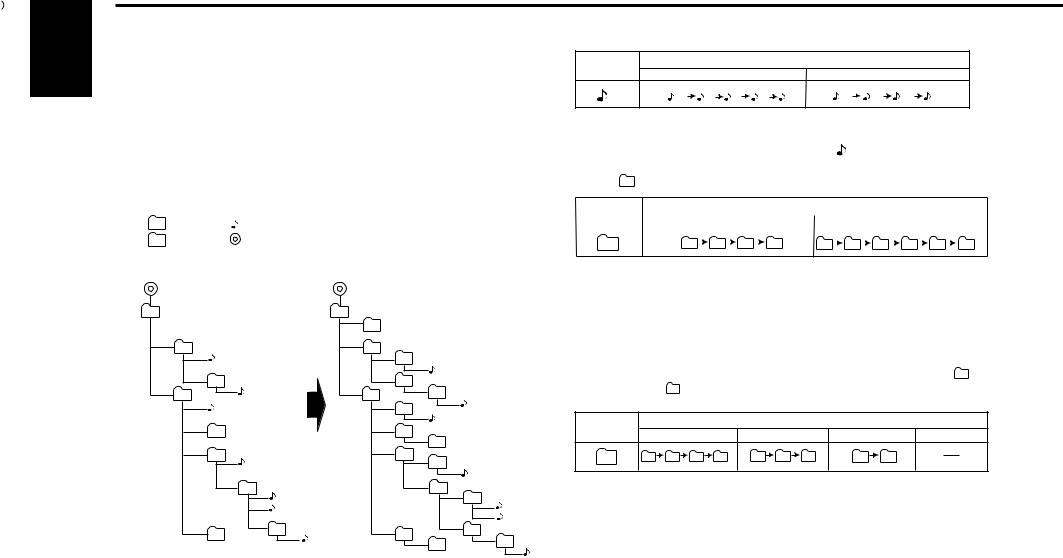
English
Notes on playing MP3 files
MP3 file playing order
When selected for play, folder search, file search, or for folder select, files and folders are accessed in the order in which they were written by the CD writer.
Because of this, the order in which they are to be recorded does not match the order in which they are played. You may be able to set the order in which MP3 files are to be played by writing them onto a medium such as a CD-R with their file names beginning with play sequence numbers such as "01" to "99", depending on your CD writer.
For example, a medium with the following folder/file hierarchy is subject to folder search, file search, or folder select as shown below.
Folder |
File |
|
|
|
|
Virtual folder |
Root |
|
|
|
|
Example of a medium's folder/file hierarchy |
Medium's virtual folder/file hierarchy |
|
|||
For a file search or folder search |
for a folder select |
|
|
||
1 |
|
1 |
|
|
|
|
|
(1) |
|
|
|
2 |
|
2 |
|
|
|
1 |
|
(2) |
|
|
|
|
|
|
1 |
|
|
3 |
|
3 |
|
|
|
4 |
2 |
4 |
(3) |
|
|
|
|
||||
3 |
|
(4) |
2 |
|
|
|
|
|
|||
|
|
|
3 |
|
|
5 |
|
5 |
|
|
|
|
|
|
(5) |
|
|
6 |
4 |
6 |
(6) |
|
|
|
|
|
|||
|
|
|
4 |
|
|
|
7 |
|
7 |
|
|
|
5 |
|
(7) |
5 |
|
|
6 |
|
|
||
|
|
|
|
||
|
|
|
|
6 |
|
9 |
8 |
9 |
8 |
|
|
7 |
(9) |
(8) |
|||
|
|
||||
|
|
|
7 |
||
|
|
|
|
||
Level 1 Level 2 Level 3 Level 4 Level 5 |
Level 1 Level 2 Level 3 |
Level 4 Level 5 |
|
||
When a file search is executed with file  4 being played ...
4 being played ...
Current |
|
|
|
Operation of the button |
|
|
|
|
|
file number |
|
4 Button |
|
|
|
¢ Button |
|
||
4 |
Beginning of |
|
|
|
|
5 |
6 |
7 |
1 |
file 4 |
3 |
2 |
1 |
7 |
|||||
When a folder search is executed with file 4 being played ...
4 being played ...
When a folder search is executed with file |
4 currently being |
|
||||||||||||||||||||
played, the unit selects folders as shown below, starting with |
|
|||||||||||||||||||||
folder |
6 . |
|
|
|
|
|
|
|
|
|
|
|
|
|
|
|
|
|
|
|
|
|
Current |
|
|
|
|
|
|
|
Operation of the button |
|
|
|
|
|
|
|
|
|
|||||
folder number |
|
|
|
|
|
|
|
|
|
|
|
|
|
|
|
|
|
|
|
|
|
|
|
|
FM Button |
|
|
|
|
|
|
|
AM Button |
|
|
|
|
||||||||
|
|
|
|
|
|
|
|
|
|
|
|
|
|
|
||||||||
6 |
7 |
|
8 |
|
9 |
|
1 |
5 |
|
4 |
|
|
3 |
|
2 |
|
|
1 |
|
|
9 |
|
|
|
|
|
|
|
|
|
|
|
|
||||||||||||
When folder select is selected with file  3 being played to move from folder to folder ...
3 being played to move from folder to folder ...
During folder select, a virtual folder is created one hierarchical level below each folder. The hierarchy is displayed as if the MP3 file recorded in each folder were placed in that virtual folder.
When the unit enters the folder select mode with file 3 being played, it selects folders as shown below, starting with folder 4 (virtual folder 4 ).
3 being played, it selects folders as shown below, starting with folder 4 (virtual folder 4 ).
Current |
|
|
|
|
|
|
Operation of the button |
|
|
|
folder number |
|
4 Button |
|
|
¢ Button |
AM Button |
FM Button |
|||
|
|
|
|
|||||||
4 |
9 |
6 |
5 |
4 |
5 |
6 |
9 |
4 |
1 |
|
— 6 —

NOTE
•Each virtual folder is displayed with the original folder name bounded by parentheses " ( ) ". For example, the virtual folder below the folder named " 4 " is displayed with a name of " (4) ". The file name of each virtual folder is displayed with up to 29 characters (in the ISO 9660 Level 2 format) or 10 characters (in the ISO 9660 Level 1 format), excluding the binding parentheses.
•The FM button is disabled in a folder because it has no subordinate hierarchical level below. Immediately after entering the folder select mode as in the above example,
therefore, the FM button cannot be used as there is no hierarchical level below folder4 .
Once you have moved to folder 1 using the folder select function, for example, you can use the FM button to select folder  one level below.
one level below.
— 7 —
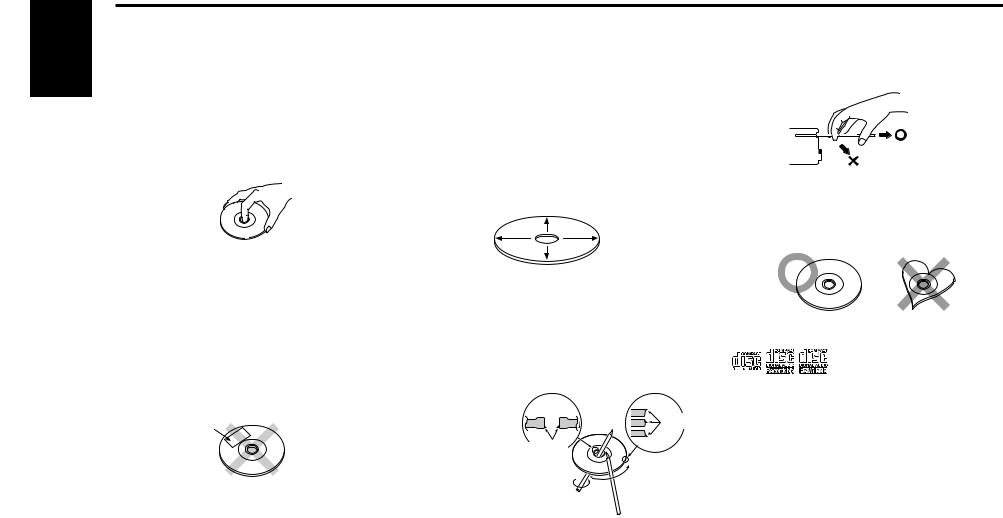
English
Handling Compact discs
Playing a CD that is dirty, scratched or warped can cause the sound to skip and the unit to operate incorrectly, resulting in worsened sound quality. Take the following precautions to prevent your CDs from getting scratched or damaged.
Handling CDs
•Do not touch the recorded side of the CD (the side opposite the label) when holding it.
•The reflective film on a CD-R or a CD-RW is more fragile than that on an ordinary music CD, and may peel off if scratched.
Fingerprints on a CD-R or CD-RW are also more likely to cause skipping when the disc is played. For these reasons, handle the disc very carefully.
Detailed handling instructions will appear on the CD-R or CD-RW package: read this information carefully before using the disc.
•Do not stick tape on either side of the CD.
Tape
Storing CDs
•Do not store CDs in areas exposed to direct sunlight (such as a car seat or the dashboard) or other hot places. A CD-R or CD-RW is more susceptible than a music CD to damage from high temperatures and humidity, and in some cases, may become unusable if left in the car for long periods of time.
•Remove CDs from the unit when not listening to them for a while, and put them back in their cases. Do not pile up CDs that are removed from their cases or prop them against something.
Cleaning CDs
If a CD has gotten dirty, wipe it off gently using a commercially available cleaning cloth or a soft cotton cloth, starting from the center of the disc and moving outward. Do not clean CDs with conventional record cleaners, anti-static formulas, or chemicals such as paint thinner or benzene.
Removing the CD
Only remove the CD from the machine in a horizontal direction, holding it flat. You may damage the surface of the CD if you try pulling it down as it ejects.
Do Not Use Special Shape CDs
•Be sure to use round shape CDs only for this unit and do not use any special shape CDs. Use of special shape CDs may cause the unit to malfunction.
Checking New CDs for Burrs
When playing a new CD for the first time, check that there are not any burrs stuck to the perimeter of the disc or in the central hole. CDs with burrs stuck on them may not load properly or may skip while playing. Remove burrs using a ballpoint pen or a similar utensil.
Burrs
Burrs
Do Not Load CD Accessories
Do not use commercially available CD accessories that can be loaded into the CD slot, such as stabilizers, protective sheets, or CD cleaning discs, since they can cause the unit to malfunction.
•Do not use any CD which does not bear one of the following marks:
•CD-Rs and CD-RWs which have not undergone finalization processing cannot be played. (For more information on finalization processing, refer to the manual for your CD- R/CD-RW writing software or CD-R/CD-RW recorder.) Additionally, depending on the recording status, it may prove impossible to play certain CDs recorded on CD-R or CD-RW.
Do Not Use CDs with Sticker on the Labeled Side
Do not use the CD with the label sticker stuck on it.
Using such a CD may cause the CD to be deformed and the sticker to peel off, resulting in malfunction of the unit.
— 8 —
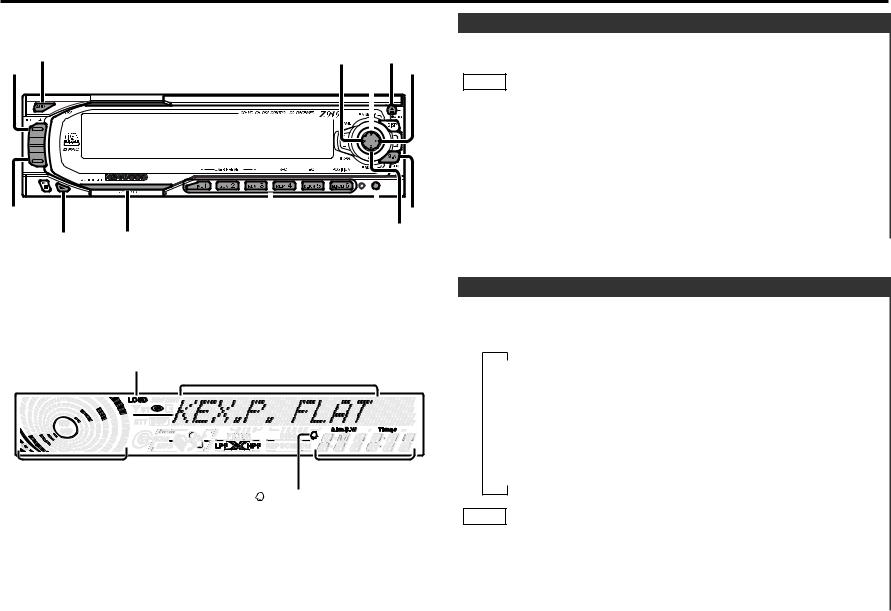
General features
AUD/
LOUD
u
d
S/S |
SRC/ |
|
PWR OFF |
LOUD indicator
Round sound level indicator
4 FM ANG ¢
|
|
|
|
|
S.A |
|
|
|
|
|
|
|
|
|
|
|
|
|
|
|
|
|
|
|
|
|
|
|
|
|
|
|
|
|
|
|
|
|
|
AM |
|
#1 - 6 |
CLK/ |
||||
ADJ
Setting display
Clock display
indicator
Power
Turning on the power:
Press the SRC (source) button.
NOTE
Turn the power on before carrying out the following procedures.
Turning off the power:
Press the PWR OFF button for at least one second.
Selecting standby mode:
Press the SRC button repeatedly and switch to "ALL OFF". When "ALL OFF" is displayed, the standby mode is activated. The standby mode turns all functions off while leaving the power to the unit on. Use this mode when you want to have the display illuminated but don't want to listen to anything.
Switching Modes
Switching Modes:
Each time you press the SRC (source) button, the mode switches as follows:
▼
Tuner mode
▼
CD/MP3 mode
▼
External disc control mode
▼
External TV control mode
▼
Standby mode
NOTE
•The mode switches to the next mode from any mode which cannot be used.
•The external disc and TV control mode will differ depending on the unit that is connected.
•MP3 files can be played only on this unit.
— 9 —
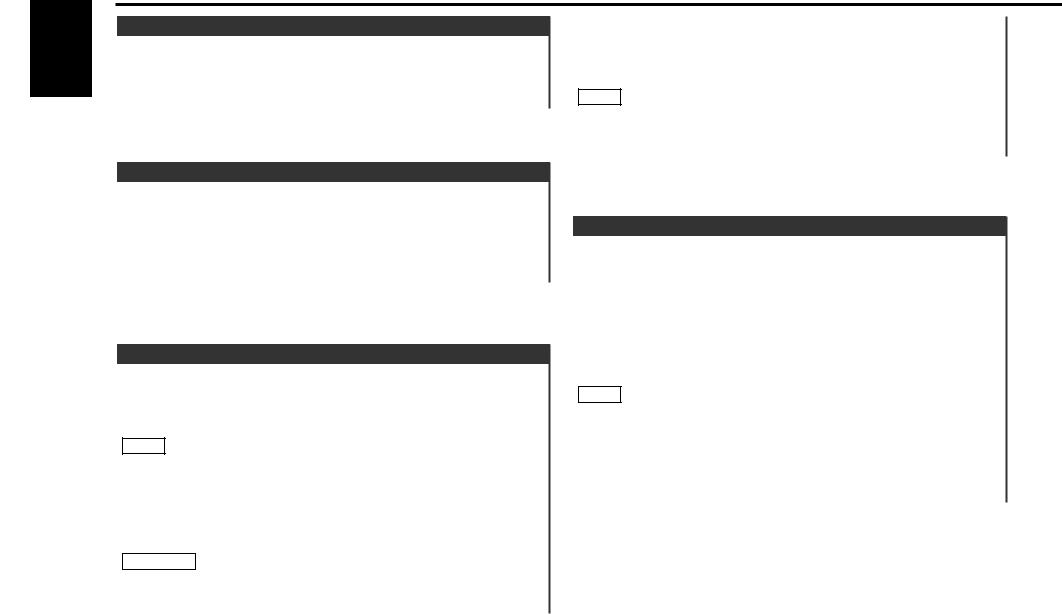
English
General features
Volume
Increasing Volume:
Press the u button to turn up the volume.
Decreasing Volume:
Press the d button to turn down the volume.
•When the front panel has been slid, it might interfere with the shift lever or something else. If this happens, pay attention to safety and move the shift lever or take an appropriate action, then operate the unit.
•Do not apply excessive force to the front panel after it slides.
NOTE Protect function for the panel
The panel may move due to the protection mechanism, if any buttons are pressed with excessive force while the panel angle is adjusted to the slide position.
Loudness
This function amplifies low and high tones when the volume is turned down.
The LOUD indicator lights up when the loudness function is on.
Turning Loudness On/Off:
Press the LOUD button for at least one second to switch the loudness on and off.
Panel Angle Adjustment
You can adjust the front panel angle for easy viewing.
Sliding the panel:
Each time you press the ANG button for at least one second, the front panel will slide to three positions step by step.
NOTE
If the power is turned off, the front panel will close automatically. When you turn the power back on, the panel angle will return to the adjusted angle position.
Closing the panel:
Press the ANG button for at least one second repeatedly until the front panel closes.
2CAUTION
•Take care that your fingers and so on do not get caught during the slide operation of the front panel.
Clock Adjustment
Adjust the clock.
1Press the CLK button to select the clock mode.
Once the clock mode is selected, "CLOCK" will be displayed.
Adjusting the Clock:
2Press the ADJ button for at least two seconds.
"CLOCK ADJ" is displayed, and then you can adjust the time.
3You can adjust hours with the FM/AM button, and minutes with the 4/¢ button.
NOTE To set the minute to "00"
Press the S/S button for at least one second to set the minute to "00".
Pressing this button while the minute is below "30" rounds it off, and while the minute is "30" or more rounds it up.
4Press the CLK button to end the clock adjustment. Adjusting the minute restarts the second counter from 00.
— 10 —
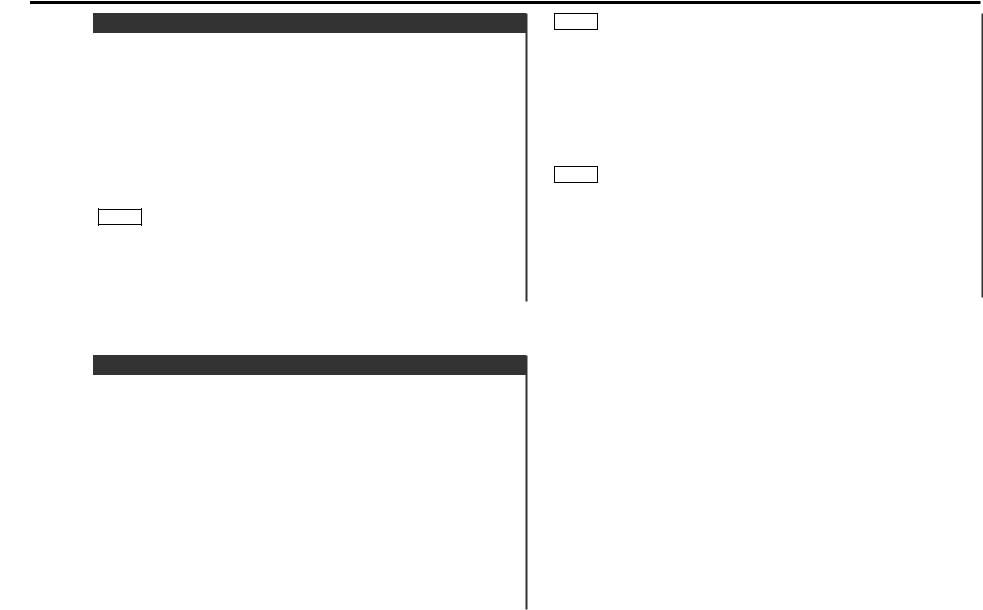
Stopwatch
You can use the clock as a stopwatch.
1Press the CLK button to select the stopwatch mode.
Once the stopwatch mode is selected, "STOP WATCH" will be displayed.
When you enter the stopwatch mode, the round sound level indicator changes its display to indicate the stopwatch mode.
2To start the measurement
Press the S/S button.
3To stop the measurement
Press the S/S button.
NOTE If you want to clear the time
Press the S/S button for at least one second.
Then the time indication will return to "0:00'00"0".
4To restart the measurement
Press the S/S button to restart the measurement.
Timer
You can use the clock as a timer. Once you set a time, the timer will beep when the set time has past.
1Press the CLK button to select the timer mode.
Once the timer mode is selected, "TIMER" will be displayed. When you enter the timer mode, the round sound level indicator changes its display to indicate the timer mode.
Time Setting:
2Press the ADJ button for at least two seconds.
"TIMER ADJ" is displayed, and then you can set a time for the timer.
3You can adjust hours with the FM/AM button, and minutes with the 4/¢ button.
NOTE To set the time to "0:00"
Press the S/S button for at least one second to return the time to "0:00".
4Press the CLK button to end the time setting for timer.
5To start the timer
Each time you press the S/S button, the timer will start and
stop.
When you start the timer, the  indicator will light up and the time counting will start.
indicator will light up and the time counting will start.
NOTE If you want to clear the setting time of the timer
Press the S/S button for at least one second.
Then the setting time of the timer will return to the time set in the step 3.
6When the time set in the step 3 has passed
The timer will beep for five seconds.
You can immediately stop the beep by pressing the S/S button, or leave it without any action for about 5 seconds.
— 11 —
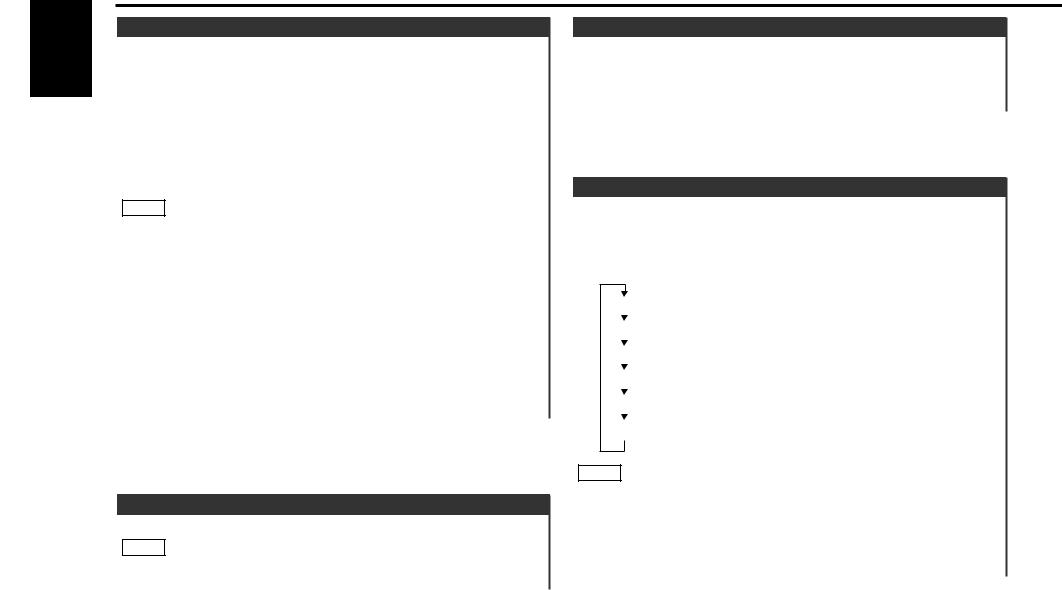
English
General features
Alarm
You can use the clock as an alarm. The alarm will beep on the time set.
1Press the CLK button to select the alarm mode.
Once the alarm mode is selected, "ALARM" will be displayed.
Time Setting:
2Press the ADJ button for at least two seconds.
"ALARM ADJ" is displayed, and you can set a time for the alarm.
3You can adjust hours with the FM/AM button, and minutes with the 4/¢ button.
NOTE To set the minute to "00"
Press the S/S button for at least one second to set the minute to "00".
Pressing this button while the minute is below "30" rounds it off, and while the minute is "30" or more rounds it up.
4Press the CLK button to end the time setting for alarm.
5To start the alarm
Press the S/S button to switch the alarm on and off. When you turn the alarm on, the  indicator will light up.
indicator will light up.
6When the time set in the step 3 has come
The alarm will beep for 15 seconds.
You can immediately stop the beep by pressing the S/S button, or leave it without any action for about 15 seconds.
Automatic Dimmer Function
The display dims when the car's lights are turned on.
NOTE
The dimmer function is not available for units if the dimmer wire is not connected.
Display Font Setting
You can change the font used on the display.
Changing the display font:
Press the S.A button for at least one second to toggle between the normal font and funky font.
Switching the Round Indicator for the Sound Level
You can change the display mode of the round sound level indicator to the left of the display.
Changing the round sound level indicator:
Press the S.A button to cycle through the round sound level indicator as shown below:
ANDROMEDA
RIPPLE
COSMOS
THE POLESTAR
PULSAR
COMET
NOTE
•You cannot switch the round sound level indicator when Silent display in the function set is on.
Set Silent display in the function set to off before you change the round sound level indicator.
•You cannot switch the round sound level indicator when the clock display is in the stopwatch mode and the timer mode.
— 12 —
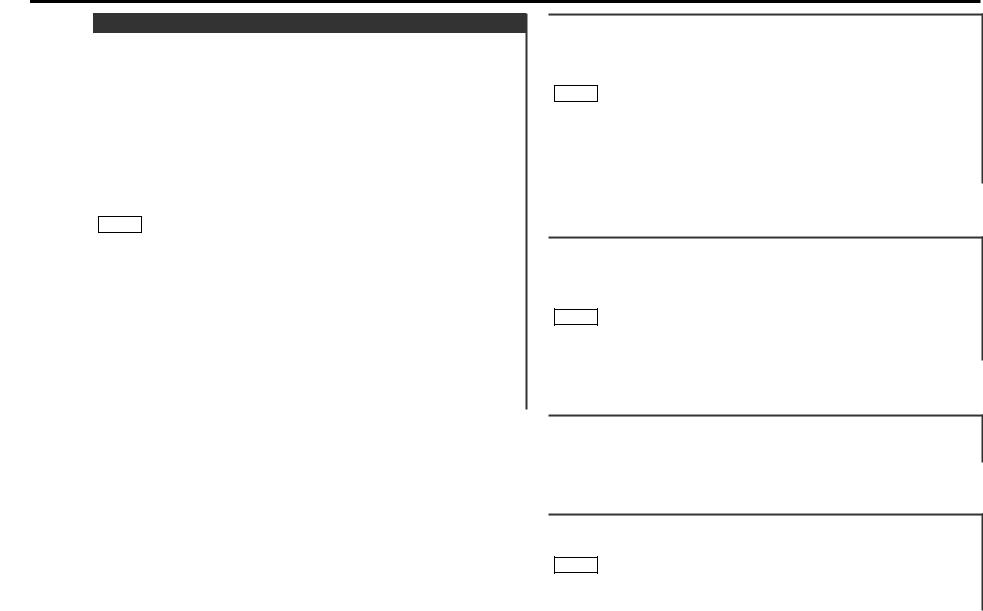
Audio Control Setting
Adjust various parameters of sound quality.
1Press the AUD button repeatedly and switch the display to “AUDIO CTRL” to enter the audio control mode.
Pressing the button cycles through Audio control mode, Crossover control mode, and Control mode off.
2Selecting mode
Press either the FM or AM button.
Each time the button is pressed, the adjustment mode will change.
Please refer to the following for the contents of the adjustment modes.
NOTE Source tone memory
Each source ( CD, FM, AM and disc changer ) has its own memory in which to store the KEX.P, bass center frequency, bass level, bass quality factor, bass extension, treble center frequency, and treble level settings.
The settings made for a particular source are recalled automatically whenever you use that source ( for example, FM mode uses the tone settings made for FM, AM for AM, etc.).
3Adjust each mode
Press the 4/¢ button.
Please refer to the following for the adjusting values.
4Press the AUD button twice to end the audio control mode.
"KEX.P." : Recalling the kenwood preset sound setting
Press the preset buttons (#1-6).
Setting values: #1;Flat, #2;Rock, #3;Top40, #4;Jazz, #5;Easy, #6;Scan of #1-5
NOTE
•This mode is available only when the Sound coordinate system is on. (page 35)
•You can call the following settings with this function; bass center frequency, bass level, bass quality factor, bass extension, treble center frequency, and treble level setting.
"BASS f" : Adjust the center frequency of the bass.
Setting values: 60 / 70 / 80 / 100 (Only when the bass quality factor is set to 1.00, 1.25 or 1.50) / 150 (Only when the bass quality factor is set to 2.00) Hz
NOTE
This mode is available only when the Sound coordinate system is on. (page 35)
"BASS" : Adjust the bass level.
Setting values: - 6 – + 6
"BASS Q" : Adjust the Bass quality factor.
Setting values: 1.00 / 1.25 / 1.50 / 2.00
NOTE
This mode is available only when the Sound coordinate system is on. (page 35)
— 13 —
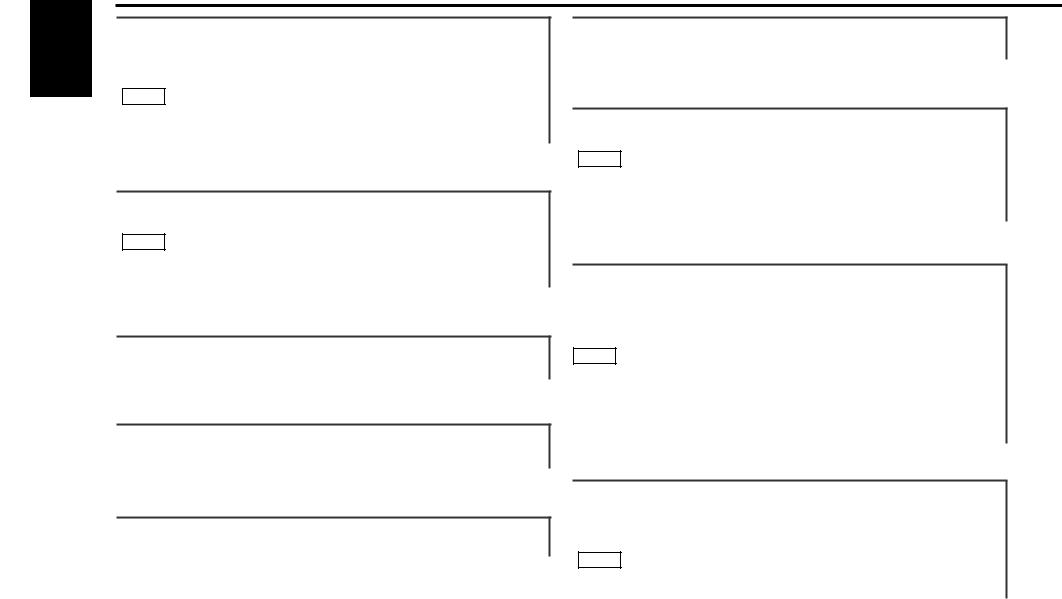
English
General features
"BASS EXT" : Switch the Bass Extend mode on/off.
Setting values: ON / OFF
(When the bass extend mode is set to on, low frequency response is extended by 20%.)
NOTE
This mode is available only when the Sound coordinate system is on. (page 35)
"TRE f" : Adjust the center frequency of the treble.
Setting values: 10.0 / 12.5 / 15.0 / 17.5 kHz
NOTE
This mode is available only when the Sound coordinate system is on. (page 35)
"TREBLE" : Adjust the treble level.
Setting values: - 6 – + 6
"BALANCE" : Adjust the balance level.
Setting values: Left 15 – Right 15
"FADER : Adjust the fader level.
Setting values: Front 15 – Rear 15
"N-F LV" : Adjust the Non-fading output level.
Setting values: - 35 – + 5
"AMP CTRL" : Set the amplifier bass increment.
Setting values: OFF/1/2
NOTE
As of December 1998, the power amplifiers controllable by the main unit are as follows: KAC-X501F/PS501F/X401M/PS401M/X301T/PS301T/X201T/PS201T
Storing your sound settings:
Press a preset button (#1-6) for at least two seconds except during the bass center frequency, bass level, bass quality factor, bass extension, treble center frequency, and treble level adjust mode.
NOTE
•This mode is available only when the Sound coordinate system is on. (page 35)
•The settings you can preset are, bass center frequency, bass level, bass quality factor, bass extension, treble center frequency, and treble level.
Recalling your sound settings:
Press a preset button (#1-6) except during the bass center frequency, bass level, bass quality factor, bass extension, treble center frequency, and treble level adjust mode.
NOTE
This mode is available only when the Sound coordinate system is on. (page 35)
— 14 —

Digital Crossover Network
Adjust various parameters of the Crossover network.
1Press the AUD button repeatedly and switch the display to “X’OVER CTRL” to enter the Crossover network control mode. Pressing the button cycles through Audio control mode, Crossover control mode, and Control mode off.
2Selecting mode
Press either the FM or AM button.
Each time the button is pressed, the adjustment mode will change.
Please refer to the following for the contents of the adjustment modes.
3Adjust each mode
Press the 4/¢ button.
Please refer to the following for the adjusting values.
4Press the AUD button once to end the Crossover network control mode.
"HPF F" : Adjust the frequency of the High-pass filter for front output.
Setting values: THROU / 40Hz / 60Hz / 80Hz / 100Hz / 120Hz / 150Hz / 180Hz / 220Hz
NOTE
You can separately set the high-pass filter for front and rear output,including preouts. The high-pass filter does not affect the non-fading preout.
"HPF R" : Adjust the frequency of the High-pass filter for rear output.
Setting values: THROU / 40Hz / 60Hz / 80Hz / 100Hz / 120Hz / 150Hz / 180Hz / 220Hz
NOTE
You can separately set the high-pass filter for front and rear output, including preouts. The high-pass filter does not affect the non-fading preout.
"LPF NF" : Adjust the frequency of the Low-pass filter for NonFading output.
Setting values: 50 Hz / 80 Hz / 120 Hz / THROU
"PHASE : Adjust the phase for Non-Fading output.
Setting values: NOR (0°) / REV (180°)
Storing your settings of the Crossover network:
Press a preset button (#1-6) for at least two seconds.
Recalling your settings of the Crossover network:
Press a preset button (#1-6) for the desired Crossover network setting.
— 15 —
